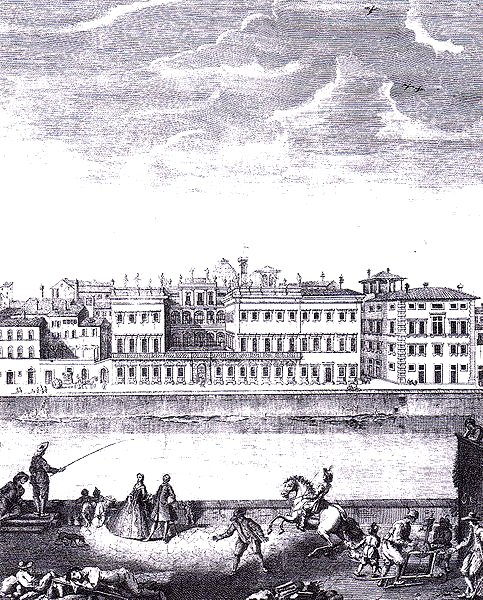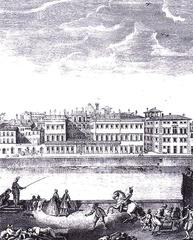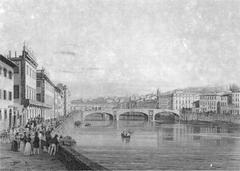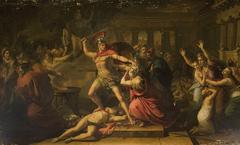
Palazzo Corsini Florence: Visiting Hours, Tickets, and Historical Sites Guide
Date: 14/06/2025
Introduction: The Grandeur of Palazzo Corsini
Palazzo Corsini, majestically situated along Florence’s Lungarno Corsini, stands as one of the city’s most significant Baroque palaces. Commissioned by the illustrious Corsini family between the mid-17th and early 18th centuries, this riverside residence reflects both the artistic ambitions and the social stature of its patrons. With its monumental architecture, lavish interiors, and unparalleled private art collection, Palazzo Corsini offers a rare window into the evolution of Florentine art and society after the Renaissance. The palace is not only a historical landmark but also a vibrant cultural hub, hosting prestigious events and festivals that continue to shape Florence’s contemporary cultural landscape (Palazzo Corsini Official).
Table of Contents
- Introduction
- Origins and Early Ownership
- Architectural Evolution and Artistic Decoration
- Historical Figures and Cultural Importance
- Architectural Features and Innovations
- Visiting Palazzo Corsini: Hours, Tickets, and Tips
- Frequently Asked Questions (FAQ)
- Explore More
- Call to Action
- References
Origins and Early Ownership
The site of Palazzo Corsini has a rich history that predates its Baroque transformation. Prior to the 17th century, it was occupied by several structures, including the Casino del Parione and the home of Tommaso Compagni, adorned with frescoes by Bernardino Poccetti. Over time, ownership transitioned from the Marquis of Marignano to Giovanni de’ Medici, and later to Cardinal Giovan Carlo de’ Medici. In 1640, Maddalena Machiavelli, mother of Bartolomeo Corsini, secured the property, paving the way for the Corsini family’s grand architectural project (Italyscapes).
Architectural Evolution and Artistic Decoration
Construction and Development
Construction of Palazzo Corsini began in 1656, spearheaded by Bartolomeo Corsini. Alfonso Parigi the Younger provided the initial designs, with Ferdinando Tacca and later Antonio Maria Ferri overseeing major developments. Ferri’s architectural vision culminated in the palace’s iconic three-wing layout, central courtyard, and the celebrated double-ramp staircase (Palazzo Corsini Official).
Interior Decoration
By 1700, Palazzo Corsini’s interiors were adorned with grand frescoes and stuccoes by masters such as Anton Domenico Gabbiani, Alessandro Gherardini, and Pier Dandini. The Hall of the Throne, with Gabbiani’s “Apotheosis of Casa Corsini,” exemplifies the palace’s artistic splendor, while other salons dazzle with Baroque allegories and mythological scenes (Italyscapes).
Art Collection
The palace houses one of Florence’s most important private art collections, featuring works by Caravaggio, Gabbiani, and Gherardini, displayed in their original context. The Galleria Corsini, with its floor-to-ceiling arrangement, mirrors the display traditions of Italy’s noble collections (Palazzo Corsini Art Collection).
Historical Figures and Cultural Importance
Palazzo Corsini’s significance is heightened by its association with Lorenzo Corsini, who became Pope Clement XII in 1730. His statue stands atop the palace’s grand staircase—a tribute to the family’s religious and political influence (Italyscapes). Over the centuries, the palace has hosted grand receptions, scholarly gatherings, and cultural festivities, solidifying its role as a focal point of Florence’s elite society.
Architectural Features and Innovations
Palazzo Corsini is a rare example of Baroque architecture in Florence, contrasting with the city’s Renaissance heritage. Notable features include:
- Monumental Staircase: Designed by Antonio Maria Ferri, this double-ramp staircase is celebrated for its scale and artistry.
- Riverside Façade: The palace’s façade, with its pilasters and terracotta vases, creates a dramatic presence on the Arno.
- Central Courtyard: The U-shaped plan opens toward the river, maximizing light and creating a sense of theatricality.
- Nymphaeum and Grotto: Ferri’s artificial grotto and water features add to the palace’s Baroque charm (Palazzo Corsini Official).
Visiting Palazzo Corsini: Hours, Tickets, and Tips
Visiting Hours
Palazzo Corsini is open to the public by appointment, primarily through guided tours. Standard hours are Monday to Friday, 9:00 AM to 5:00 PM, though special events may affect availability. Check the latest schedule on the official website.
Ticket Information
- Admission: Entry is by guided tour only.
- Pricing: Tickets typically range from €12 to €15, with concessions for students and seniors.
- Booking: Advance reservations are required; book via the official Palazzo Corsini website.
Accessibility
While the palace’s historic structure presents some challenges, ramps and an elevator provide access to exhibition areas. Visitors with specific needs should contact the palace in advance to arrange accommodations.
Guided Tours and Events
Guided tours explore the main salons, art collections, gardens, and panoramic terraces. The palace also hosts prominent events such as the Biennale Internazionale dell’Antiquariato di Firenze and the “Artigianato e Palazzo” festival, showcasing Florence’s artisan heritage (Artigianato e Palazzo Festival).
Photographic Highlights
- Monumental staircase crowned by Pope Clement XII’s statue
- The grand Hall of the Throne and its frescoed ceiling
- Riverside terraces with panoramic city views
Nearby Attractions
Located between Ponte Santa Trinita and Ponte alla Carraia, Palazzo Corsini is close to the Uffizi Gallery, Boboli Gardens, and Florence’s Oltrarno district, making it easy to incorporate into a broader city itinerary.
Frequently Asked Questions (FAQ)
Q: How do I book tickets for Palazzo Corsini?
A: Reservations must be made in advance via the official website or authorized partners.
Q: Are guided tours mandatory?
A: Yes, all visits are by guided tour to preserve the palace and provide historical context.
Q: Is Palazzo Corsini accessible for wheelchairs?
A: Yes, with advance notice; ramps and elevators serve main visitor areas.
Q: Can I take photographs?
A: Photography is permitted in most public areas, but restrictions may apply to protect artworks.
Q: Are gardens included in the tour?
A: The gardens are usually accessible during guided tours or special events.
Explore More
Call to Action
Plan your visit to Palazzo Corsini to experience Florence’s Baroque splendor firsthand. Book your guided tour online, download the Audiala app for interactive maps and audio guides, and follow our social media channels for updates on events and exhibitions.
Image Suggestions
- Façade of Palazzo Corsini overlooking the Arno River (alt=“Baroque façade of Palazzo Corsini overlooking the Arno River”)
- Hall of the Throne with Gabbiani’s fresco (alt=“Apotheosis of Casa Corsini ceiling fresco by Anton Domenico Gabbiani”)
- Monumental staircase and statue of Pope Clement XII (alt=“Monumental staircase crowned by statue of Pope Clement XII”)
- Giardino Corsini during the Artigianato e Palazzo festival (alt=“Giardino Corsini craftsmanship festival”)
References
- Historical Overview and Visitor’s Guide to Palazzo Corsini in Florence, 2025, Italyscapes (https://www.italyscapes.com/places/tuscany/florence/palaces/palazzo-corsini-al-parione/)
- Palazzo Corsini Official Website, 2025 (http://www.palazzocorsini.it/storia/)
- Palazzo Corsini Florence: Visiting Hours, Tickets & Architectural Highlights, 2025, Visit Florence (https://www.visitflorence.com/florence-museums/palazzo-corsini.html)
- Palazzo Corsini Florence: Visiting Hours, Tickets & Cultural Significance, 2025, Firenze Tourism (https://www.firenze-tourism.com/en/florence-attractions/florence-palaces/palazzo-corsini.html)
- Visitor Information and Practical Tips for Palazzo Corsini, 2025 (https://palazzocorsini.it)
- Artigianato e Palazzo Festival
- Italia.it Palazzo Corsini
By preparing ahead and following this guide, your visit to Palazzo Corsini will be both enriching and memorable, offering a rare encounter with the grandeur of Florence’s Baroque heritage.









































































